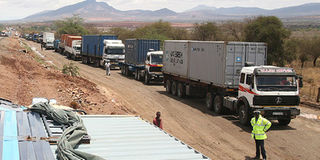Why was Ukambani town named after a Sultan?

Long-distance transport trucks near Sultan Hamud, along the Nairobi-Mombasa highway. The town got its name from Sultan Ali Hamud who ruled Zanzibar from 1902 to 1911. When construction of the railway reached present-day Sultan Hamud, the Zanzibar ruler visited to see progress and camped there for some days. That visit gave the town its name. PHOTO/FILE.
What you need to know:
- Surprisingly, even many residents of Sultan Hamud do not know the origin of their town’s name.
- Ali Hamud reigned from 1902 to 1911 and made good relations with the British, who were in charge of the railway construction.
- As the leader of Zanzibar, Sultan Hamud saw the construction of the railway line as an opportunity for his government to transact business across the two countries.
- When construction reached present-day Sultan Hamud, the Zanzibar ruler visited to see progress and camped there for some days.
- Sultan Hamud is located 109km from Nairobi and 373km from Mombasa.
- The fact that it is only 50km from the proposed Konza Technocity means it has high growth potential.
How did a town in Ukambani acquire the name of a ruler of the Indian Ocean island of Zanzibar?
This could be a question many travellers on the Mombasa highway ask themselves each time they pass through Sultan Hamud.
Surprisingly, even many residents of Sultan Hamud do not know the origin of their town’s name.
The settlement sprung up during the construction of the Kenya-Uganda railway line in the early 1900s.
At the time, a 10-mile coastal strip that is now part of Kenya was ruled from Zanzibar.
The Sultanate of Zanzibar was created on October 19, 1856 after the death of Said Bin Sultan.
He had ruled Oman and Zanzibar as Sultan of Oman since 1804, but the two were split following a succession fight.
Until 1886 when European powers moved into the region and the British took control of the island, the Sultan of Zanzibar controlled a substantial portion of the East African Coast, known as Zani.
TRADING ROUTES
Trading routes extended farther into the continent, as far as Kindu on the Congo river.
In 1886, following the division of the African hinterland between the British and the Germans, the British placed Sayyid Ali Hamud bin Mohammed in power in Zanzibar after the Anglo-Zanzibar war that lasted less than 40 minutes.
The war marked the end of the Zanzibar Sultanate as a sovereign state and the start of a period of heavy British influence.
Ali Hamud reigned from 1902 to 1911 and made good relations with the British, who were in charge of the railway construction.
Arabs who had occupied the coastal strip were involved in trade across East African countries.
As the leader of Zanzibar, Sultan Hamud saw the construction of the railway line as an opportunity for his government to transact business across the two countries.
SULTAN'S VISIT
When construction reached present-day Sultan Hamud, the Zanzibar ruler visited to see progress and camped there for some days.
That visit gave the town its name.
A mosque was built to enable him to worship, attracting more Arabs, hence the growth of Islam in the area.
Sultan Hamud died in December 1918, leaving his name as a mark in Ukambani.
The town grew slowly, with no significant change until the new Nairobi-Mombasa road was opened.
Sultan Hamud is located 109km from Nairobi and 373km from Mombasa.
It is famous as a rest stop for truck and bus drivers plying the Mombasa Road.
The town was mainly occupied by the Maasai and the Kamba communities, separated by the railway line, long before other communities settled there.
The people of Sultan Hamud are engaged in different economic activities, including farming and livestock keeping.
PRE-COLONIAL TRADING CENTER
In the pre-colonial era, it was a trading centre for the Kamba and the Maasai, who would meet to exchange agricultural products and animals.
This trading continues. Thursday is the market day, but of course barter trade is no longer in use.
The town has a small population of between 10,000 and 20,000 people.
Being one of the oldest on the Nairobi-Mombasa highway, Sultan Hamud has become a 24-hour economy.
Commercial buildings are coming up, as well as colleges and schools.
The fact that it is only 50km from the proposed Konza Technocity means it has high growth potential.
Investors are, therefore, not only finding space at Konza but are also moving down Mombasa road to occupy parts of Sultan Hamud.




